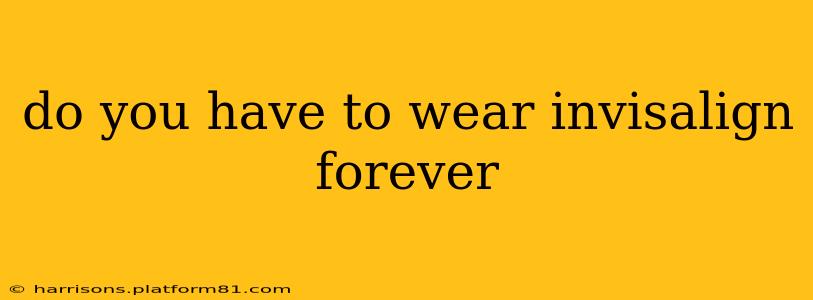Do You Have to Wear Invisalign Forever?
The short answer is no, you don't have to wear Invisalign forever. Invisalign, like traditional braces, is a temporary orthodontic treatment designed to straighten teeth and correct bite issues. The length of treatment varies depending on individual needs, but once your teeth have reached their desired position and your bite is corrected, you'll move into a retention phase. This phase is crucial for maintaining the results achieved during active treatment.
How Long Do I Need to Wear Invisalign?
The duration of active Invisalign treatment typically ranges from 6 to 24 months, although some cases may require longer. Your orthodontist will create a personalized treatment plan based on a thorough examination of your teeth and bite. This plan will outline the number of aligners you'll need and the approximate timeframe for treatment. Factors influencing treatment length include:
- Severity of misalignment: Minor crowding or spacing will generally require less time than significant malocclusion.
- Patient compliance: Consistent wearing of the aligners as directed is essential for successful treatment. Missing aligner wear time can significantly prolong the process.
- Individual response to treatment: Every patient's teeth respond differently to orthodontic forces.
What Happens After Active Invisalign Treatment?
Once your active treatment is complete, you'll transition to the retention phase. This is equally important as the active phase, as it prevents your teeth from shifting back to their original positions. Retention typically involves wearing:
- Retainers: These are custom-made appliances designed to hold your teeth in their new, corrected positions. Retainers can be removable (like clear aligners or wire retainers) or fixed (bonded to the back of your teeth).
- Vivera retainers: These are essentially clear aligners used for long-term retention. They mimic your final set of Invisalign aligners.
The length of time you need to wear retainers depends on several factors, including your age and the severity of your initial misalignment. Your orthodontist will provide personalized recommendations, but generally, you'll wear retainers for at least several months to several years, and in many cases indefinitely, especially at night.
What If I Stop Wearing My Retainers?
Stopping retainer wear after active Invisalign treatment significantly increases the likelihood of your teeth shifting back to their original positions. This can lead to a relapse, requiring further orthodontic treatment to correct the misalignment. While some minor shifting is possible, consistent retainer use minimizes this risk.
How Often Do I Need to See My Orthodontist After Invisalign?
Regular checkups with your orthodontist are vital throughout the entire process, including after active treatment. These appointments allow your orthodontist to monitor your progress, make adjustments if needed, and ensure your retainers are fitting correctly. The frequency of these appointments will be determined by your orthodontist, but it's typically less frequent than during active treatment.
Can I Get My Teeth Straightened Without Invisalign or Braces?
While Invisalign and braces are the most common and effective orthodontic treatments, other options exist, such as clear aligners from other brands or certain cosmetic procedures. However, these alternatives may not address all types of misalignment as comprehensively as Invisalign or braces. It’s crucial to consult an orthodontist to determine the most appropriate treatment plan for your specific needs.
In conclusion, while you don't wear Invisalign aligners forever, maintaining the results of your Invisalign treatment requires long-term commitment to wearing retainers. This proactive approach ensures your smile remains straight and healthy for years to come. Always follow your orthodontist's instructions carefully to achieve the best possible outcome.
